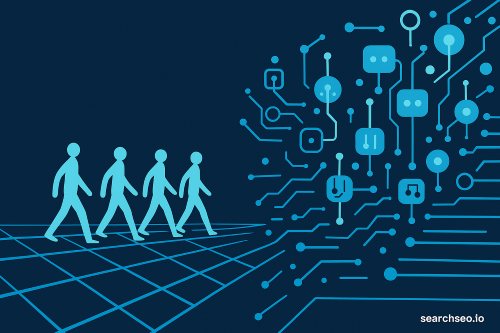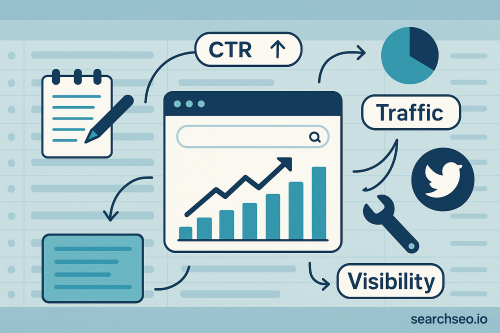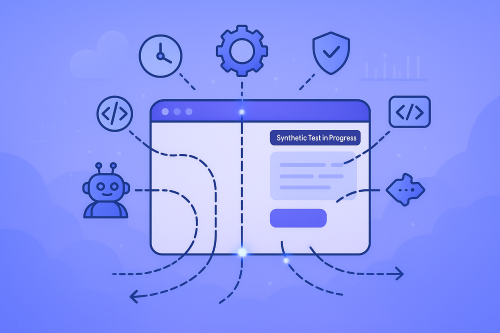If the internet feels “busier” lately, you’re not imagining it, you’re just not sharing it with as many humans anymore.
Year after year, bot traffic grows faster than real user traffic, and the gap is widening. Security firms and infrastructure providers are all reporting the same thing: bots now outpace humans online, driven by AI acceleration, automated scraping, and increasingly sophisticated cybercrime.
So why is this happening, and what does it mean for SEOs, marketers, and business owners?
Let’s break it down.

The short version: bots are easier, cheaper, and smarter than ever
Three megatrends are pushing bot traffic to an all-time high:
- AI lowered the barrier to creating bots.
Anyone can now spin up realistic, adaptive, human-like automation in minutes. - Cybercriminals innovate faster than defenses.
Credential stuffing, inventory hoarding, account takeovers, automation makes it all scalable. - Brands built APIs, apps, and public-facing front doors everywhere.
And bots love a good open door.
But the “why” behind each trend matters, especially if you’re responsible for protecting a site, measuring traffic quality, or improving organic visibility.
1. AI is supercharging bots in ways never seen before
The old bots? Predictable. Repetitive. Easy to filter.
The new bots? They look and move like real users.
AI is helping:
- Create human-like mouse movements and scroll behavior
- Mimic real session flows and adapt on the fly
- Bypass basic bot detection, including CAPTCHAs
- Scale operations cheaply through cloud infrastructure
This is why bad bots can now scrape faster, commit fraud more effectively, and infiltrate login flows without raising obvious red flags.
And because AI is accelerating every year, the bot problem grows exponentially, not linearly.
2. Cybercrime shifted from manual attacks to full automation
Cybercriminals don’t “try things” anymore — they deploy bots that try millions of things.
Some of the fastest-growing categories:
Credential stuffing
Bots test stolen username/password combos across thousands of services.
Fake account creation
AI-generated identities + automation = unlimited fake profiles, reviews, applications, and signups.
Payment fraud
Bots test card numbers, refund systems, and checkout vulnerabilities at scale.
Scraping & data harvesting
Competitors and malicious actors constantly scrape product listings, pricing, content, and internal APIs.
Attackers aren’t more creative than before, they’re just more automated.
3. The commercial internet created more “targets” than humans can fill
Every new digital surface becomes a playground for bots:
- Ecommerce product pages
- Search results
- Pricing pages
- Login flows
- API endpoints
- Knowledge bases and customer support sites
- Local business listings
And as companies ship more features, publish more content, and open more API-based experiences…
Bots multiply to match the opportunity.
Humans don’t scale that fast, bots do.
4. Traffic inflation is a convenient side effect (for some)
Not all bot growth is malicious.
Some of it comes from:
- Search engine crawlers
- AI crawlers collecting training data
- Performance monitoring tools
- Competitive intelligence scrapers
- Price comparison engines
- Third-party marketing scripts
Most businesses don’t realize how much “extra noise” hits their site daily. So when people say traffic is rising? Often it’s just non-human sessions doing the rising.
This creates the illusion of growth, while masking real user behavior.
5. Bot traffic is outpacing humans because bots don’t sleep
Humans browse in peaks. Bots browse 24/7.
That alone gives bots a massive volume advantage:
- No time zones
- No workday dips
- No seasonal behavior
- No attention limits
- No cognitive load
When you automate traffic, your ceiling is literally the speed of your server.
Why this matters for SEOs, marketers, and site owners
Here’s the uncomfortable truth:
If you’re not accounting for bot traffic, you’re making decisions using inaccurate data.
Bots skew:
- Organic traffic metrics
- CTR trends
- Bounce rates
- Conversion funnels
- Page performance
- Competitor analysis
- API usage
- Content scraping exposure
They also distort the true ROI of your SEO work.
And because bots are growing faster than humans, every year your analytics get a little noisier unless you actively filter or segment traffic.
The takeaway
Bot traffic is rising faster than human traffic because automation is easier, cheaper, smarter, and more scalable than ever. AI poured gasoline on the problem, cybercrime industrialized it, and the modern web created endless opportunities for bots to thrive.
If you ever plan to use traffic bots in your SEO mix, choose wisely. The only safe route is choosing traffic that mimics real human behavior — real browsers, real residential IPs, natural click patterns — so your analytics stay trustworthy and your signals stay authentic.


.svg)

.svg)
%201.png)








.svg)